Learn How to Solo With Chords Jazz Style (Part 2)
Master the beautifully musical style of soloing with chords, just like the jazz greats.

In our previous instalment of this lesson, we looked at how to solo with chords, a technique that blurs the line between lead and rhythm playing. As we discussed, soloing with chords requires both a knowledge of music theory and the fretboard in order to use it creatively and technically. However, as we saw in the first batch of examples, it’s possible to develop knowledge and skill in this area through a series of conceptual and practical exercises.
Once again, our examples will focus on the genre of jazz, which will allow us to experiment with a wide range of melodic, harmonic and modal concepts and devices, from working with fundamental modes and harmonic contexts to resolving major and minor ii - V progressions.
These approaches can also be applied to other styles, such as blues, rock, soul/R&B and pop, and can improve your soloing skills and offer greater harmonic support and independence, especially when playing in a small ensemble, such as a guitar-bass-drums trio, as well as help you play lead using more than just single notes.
In this second and final part to our lesson, we’ll look at six examples that demonstrate the following:
• How to quickly describe a variety of fundamental modes and harmonic contexts (Dorian, Lydian, Mixolydian and altered-dominant) wherever you are on the fretboard.
• Useful and harmonically appropriate solutions for navigating the essential major and minor ii - V progressions all over the neck.
We’ll conclude this masterclass with an extended chord solo that demonstrates how all of these concepts and devices may be applied in a real-world musical context.
All the latest guitar news, interviews, lessons, reviews, deals and more, direct to your inbox!
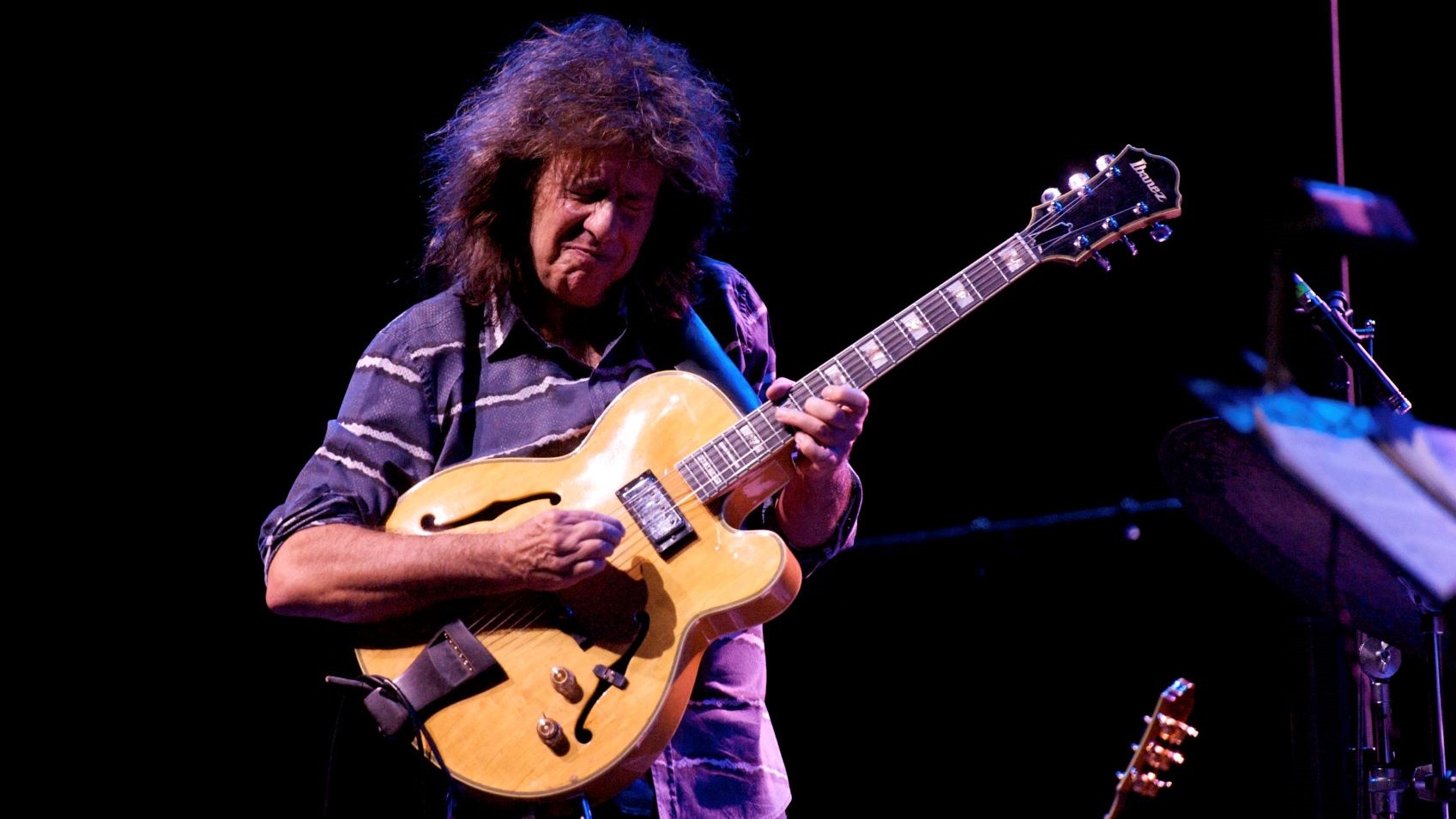
The examples presented here begin with Ex. 6, as they continue on from the last five examples in the previous instalment. As in part one, we’re using only one key center for each concept, for purposes of illustration and comparison, but transposing and applying these ideas to different keys and contexts is essential to properly absorb them, so be sure to do that on your own.
Now dial in a clean, warm electric guitar tone, and let’s get started!
Rather than considering chords to only be unmovable blocks, it’s liberating to think of a key area or tonal environment and use chords derived from a scale or mode in a more fluid manner, particularly when “hanging out,” or vamping, on a single chord for several bars. This approach also offers more options for playing chords in conventional progressions.
Such great guitarists as Pat Metheny, Bill Frisell, Joe Dioro, Kenny Burrell, Emily Remler, Scott Henderson and Allan Holdsworth have employed this modal approach with brilliant results.
There are many modes and concepts to explore, but we’ll narrow things down here and focus on the highly appealing and useful Dorian, Lydian and Mixolydian modes, as well as the very tense-sounding altered-dominant-7th tonality.

Ex. 6 presents a number of great-sounding chords, all over the neck, that effectively describe the sound of the D Dorian mode (D, E, F, G, A, B, C), which is the second mode of the C major scale (C, D, E, F, G, A, B). The signature, or “character,” note of the Dorian mode, which is one of the major scale’s three minor modes, is its major 6th, which in D Dorian is B, and you’ll see that note appear in many of these voicings.

In Ex. 7, the fourth mode of C major, F Lydian (F, G, A, B, C, D, E) – with its raised, or “sharped,” 4th (#4), B, which may also be reckoned as the #11 – adds its characteristic beautifully “floating” quality to a major tonality. Lydian-based chord voicings and extensions work great when staying on a major 7 chord for two or more bars, and also for when the chord is not the “I” (one), and for ending chords too, even if it is the “I.”

The Mixolydian mode, which is a major mode characterized by its lowered, or “flatted,” 7th, is a top choice to play over a dominant 7th chord, with which it perfectly “agrees.” The voicings presented in Ex. 8 all live within G Mixolydian (G, A, B, C, D, E, F), which is the C major scale’s fifth mode and is made up of the same seven notes as that scale, as well as those of D Dorian and F Lydian, which in this case are all the natural notes (no sharps or flats).
The voicings shown here serve as useful chord-soloing options when playing over a stationary, or static, dominant-7 tonality, be it in a jazz context or a funk or blues setting.

In Ex. 9, the altered-dominant scale, also known as the super-Locrian mode, which is intervallically spelled 1, b2 (or b9), b3 (or #9), 3, #4 (or b5, or #11), #5 (or b13), b7, creates maximum dissonance and tension without “breaking” the dom7 chord. It contains the root, major 3rd and b7th to define its essential quality, but all other scale degrees are altered from their natural position, hence b9, #9, b5 and b13.
The A altered-dominant scale is spelled A, Bb, B# (or C), C#, Eb, F, G. Some players also include the natural 5th (as we’ve done here in a couple of the chords), which in this case is the note E. We’ve also included the natural 13th, F#, which creates a very John Scofield-esque sound, especially when paired with a #9 or b9.
These notes sound great over a dominant 7th chord with altered extensions and/or whenever you want to create heightened harmonic-melodic tension before resolving down a 5th or up a 4th to a major- or minor-type 7th chord. By the way, you’ll find it helpful to know that the altered-dominant scale, or super-Locrian mode, is the seventh mode of the melodic minor scale, which in this case would be b melodic minor (Bb, C, Db, Eb, F, G, A).
Let’s now turn our attention to the ubiquitous ii - V - I (two - five- one) cadence, or mini-progression, which is a fundamental cornerstone of jazz harmony that warrants complete theoretical and practical understanding for any aspiring jazz musician. It’s defined as a type of minor chord (as indicated by the lowercase Roman numeral “ii”) going up a 4th (or down a 5th) to a type of dominant 7th chord, which in turn then moves up a 4th (or down a 5th) to a root chord – the “one.”
There are two types of ii - V cadences: 1) major ii - V, which is minor 7 chord (m7), progressing to a dominant 7, and 2) minor ii - V, which is a minor-7 flat-5 chord (m7b5) moving to a dominant 7, which usually has “altered” extensions, such as b9, #9 and b13.
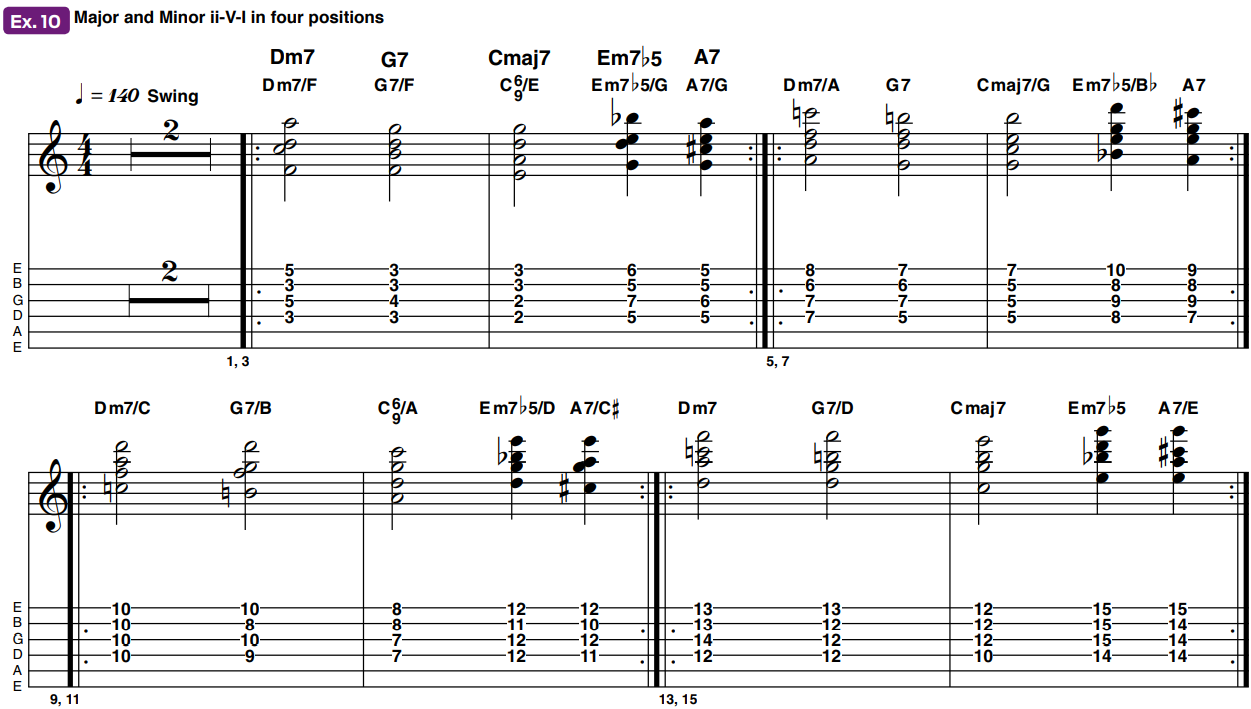
Major and minor ii - V cadences expect resolutions to major and minor chords, but counterexamples of unresolved, “roving” ii-Vs are numerous and well established in many jazz tunes. In Ex. 10, we’ve used the repeating progression Dm7 - G7 - Cmaj7 - Em7b5 - A7, which embeds both types of ii - V cadences very neatly and offers tons of scope for soloing.
For this example, we employed the voicings of Dm7, G7 and Cmaj7 from Examples 3–5 [see part one of “Learn How to Solo With Chords Jazz Style”] to create a major ii - V - I and a minor ii - V (by altering the 5th of the m7 voicings) in four different positions on the fretboard with the chords Em7b5 and A7b9.
These voicings are great for harmonizing solos (as Joe Pass and Wes Montgomery did so well) and interjecting little comping patterns between single-note phrases.

Ex. 11 takes the shapes from last instalment's Ex. 5 and adds some extensions and alterations to create more flavor and flow. With these tools you can ultimately navigate a lot of standard jazz repertoire in any key and fretboard position.
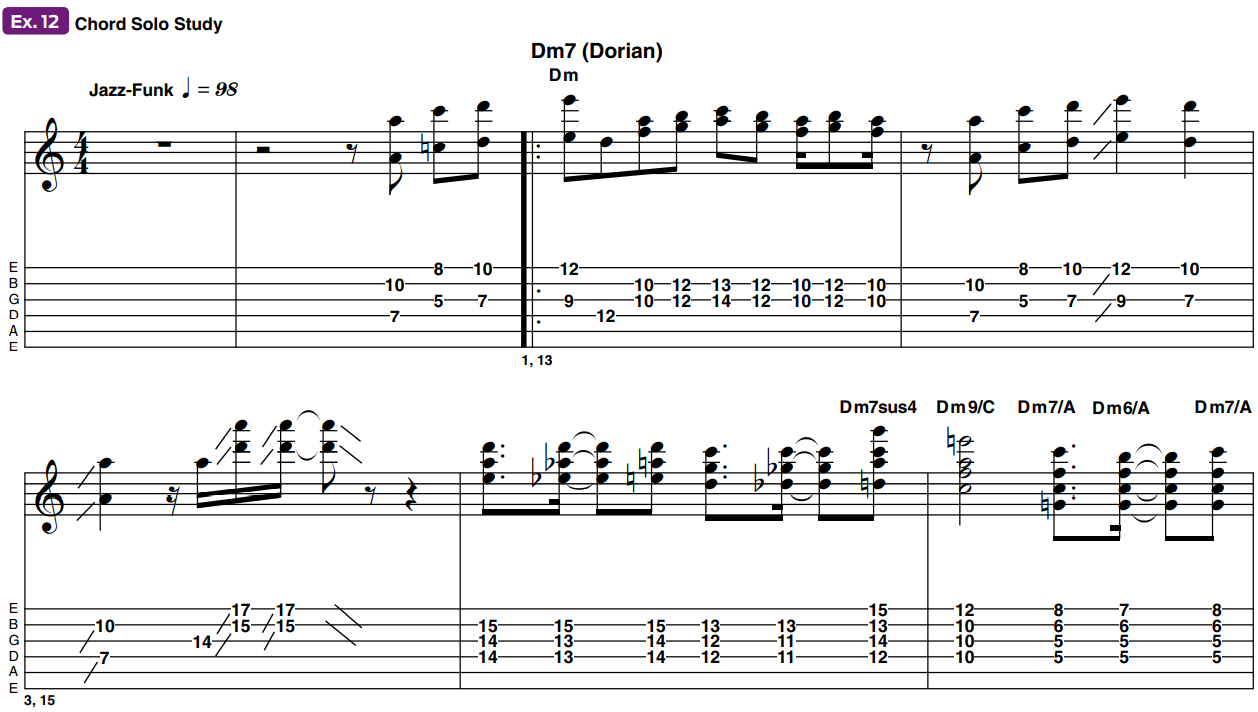
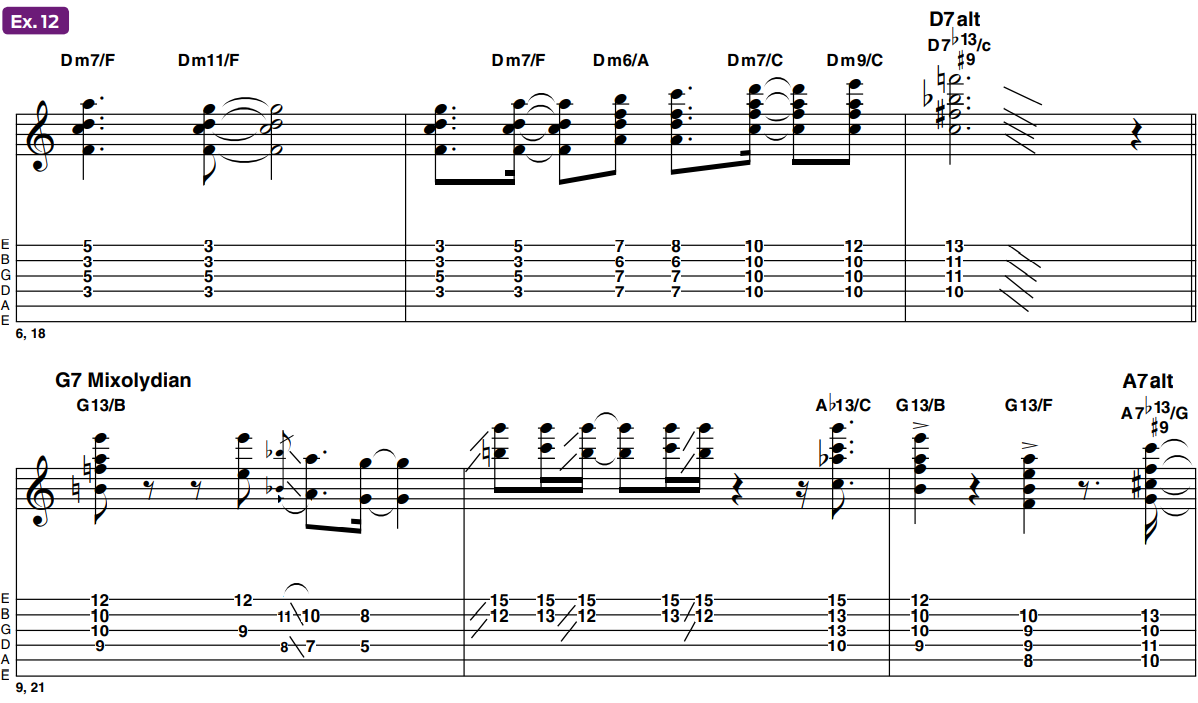
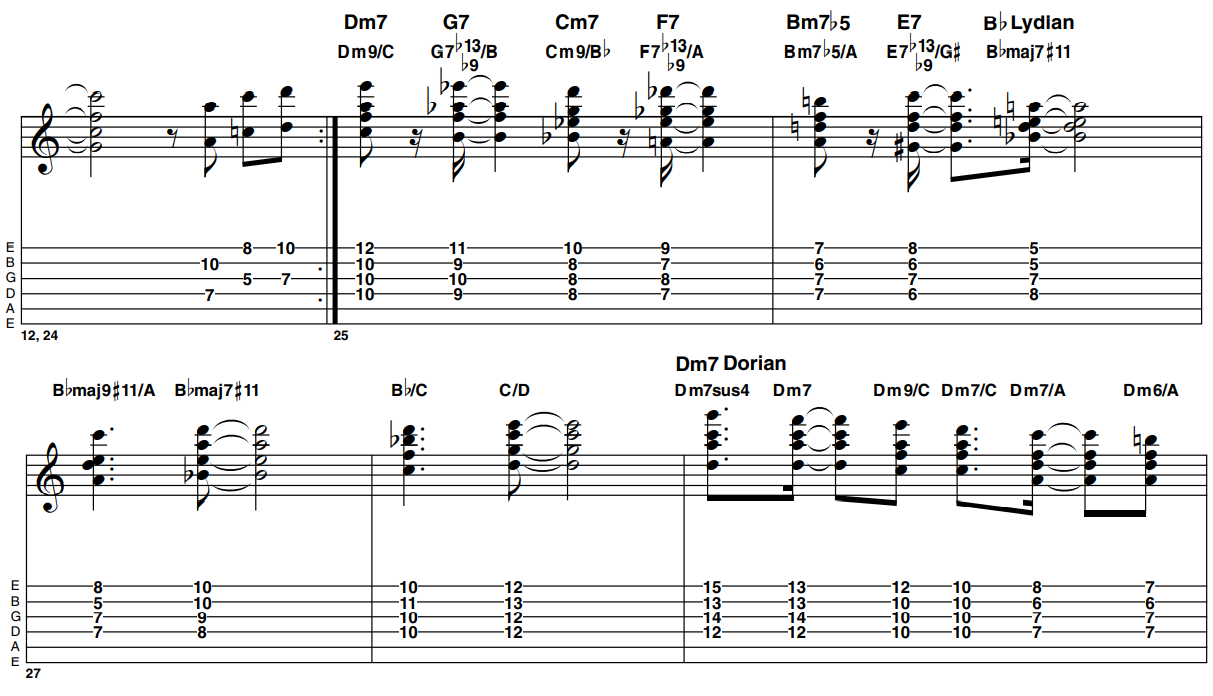

All the concepts presented in parts one and two of this lesson come together in the chord solo presented here in Ex. 12. This solo demonstrates just one of countless possibilities that are available using these approaches and harmonic devices.
Once you’ve learned the solo, have a go at building your own original chord solos using the materials presented in this two-part lesson as starting points.
